非谓语讲义教师版
- 格式:doc
- 大小:126.00 KB
- 文档页数:15


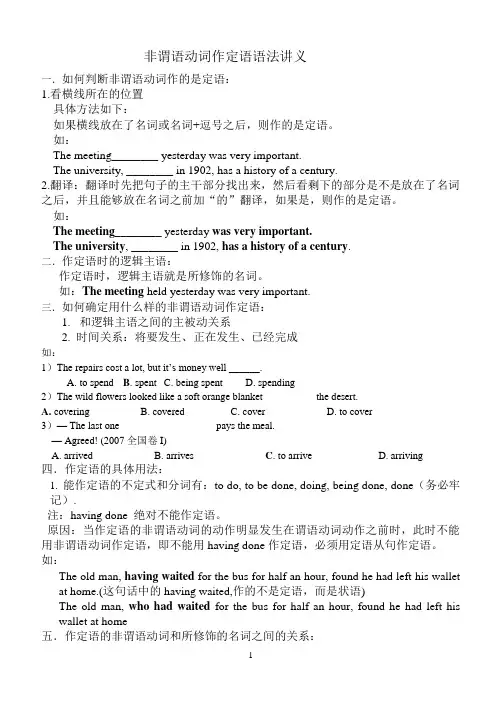
非谓语动词作定语语法讲义一.如何判断非谓语动词作的是定语:1.看横线所在的位置具体方法如下:如果横线放在了名词或名词+逗号之后,则作的是定语。
如:The meeting________ yesterday was very important.The university, ________ in 1902, has a history of a century.2.翻译:翻译时先把句子的主干部分找出来,然后看剩下的部分是不是放在了名词之后,并且能够放在名词之前加“的”翻译,如果是,则作的是定语。
如:The meeting________ yesterday was very important.The university, ________ in 1902, has a history of a century.二.作定语时的逻辑主语:作定语时,逻辑主语就是所修饰的名词。
如:The meeting held yesterday was very important.三.如何确定用什么样的非谓语动词作定语:1.和逻辑主语之间的主被动关系2. 时间关系:将要发生、正在发生、已经完成如:1)The repairs cost a lot, but it’s money well ______.A. to spendB. spentC. being spentD. spending2)The wild flowers looked like a soft orange blanket__________ the desert.A. coveringB. coveredC. coverD. to cover3)— The last one __________________ pays the meal.— Agreed! (2007全国卷I)A. arrivedB. arrivesC. to arriveD. arriving四.作定语的具体用法:1. 能作定语的不定式和分词有:to do, to be done, doing, being done, done(务必牢记).注:having done 绝对不能作定语。
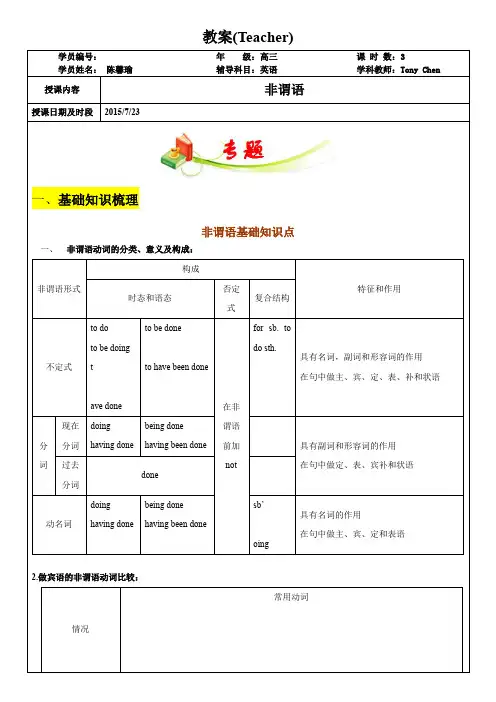
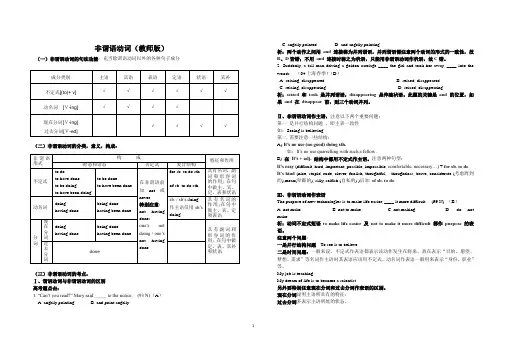
非谓语动词(教师版)(一)非谓语动词的句法功能:充当除谓语动词以外的各种句子成分(二)非谓语动词的分类,意义,构成:(三)非谓语动词的考点:Ⅰ、谓语动词与非谓语动词的区别高考题点击:1. “Can’t you read?” Mary said _____ to the notice. (93 N)(A)A. angrily pointingB. and point angrilyC. angrily pointedD. and angrily pointing析:两个动作之间用and 连接称为并列谓语,并列谓语需注意两个动词的形式的一致性,故B、D皆错;不用and 连接时称之为状语,只能用非谓语动词作状语,故C错。
2. Suddenly, a tall man driving a golden carriage ____ the girl and took her away, ____ into the woods. (04上海春季)(D)A. seizing, disappearedB. seized, disappearedC. seizing, disappearingD. seized, disappearing析:seized 和took 是并列谓语,disappearing 是伴随状语。
此题的关键是and 的位置,如果and 在disappear 前,则三个动词并列。
Ⅱ、非谓语动词作主语,注意以下两个重要问题:第一是并行结构问题,即主表一致性如:Seeing is believing.第二需要注意一些结构:A)It’s no use (no good) doing sth.如:It’s no use quarrelling with such a fellow .B) 在It’s + adj. 结构中都用不定式作主语。
注意两种句型:It’s easy (difficult, hard, important, possible, impossible, comfortable, necessary…) + for sb. to do It’s kind (nice, stupid, rude, clever, foolish, thoughtful, thoughtless, brave, considerate (考虑周到的),mean(卑鄙的), silly, selfish (自私的) )后加of sb. to doⅢ、非谓语动词作表语The purpose of new technologies is to make life easier, ____ it more difficult. (99 N) (B)A. not makeB. not to makeC. not makingD. do not make析:动词不定式短语to make life easier 及not to make it more difficult 都作purpose 的表语。
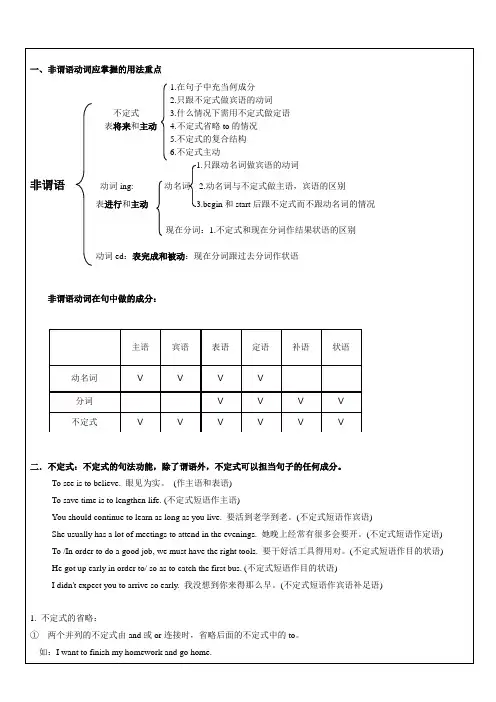
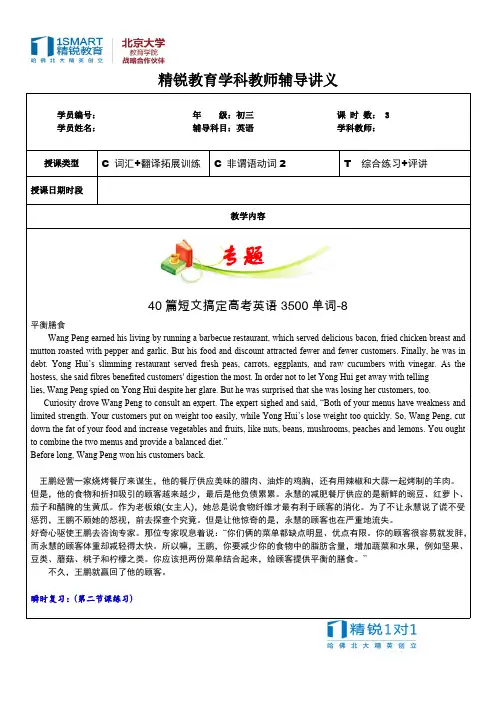
精锐教育学科教师辅导讲义学员编号:年级:初三课时数: 3学员姓名:辅导科目:英语学科教师:授课类型 C 词汇+翻译拓展训练 C 非谓语动词2T 综合练习+评讲授课日期时段教学内容40篇短文搞定高考英语3500单词-8平衡膳食 Wang Peng earned his living by running a barbecue restaurant, which served delicious bacon, fried chicken breast and mutton roasted with pepper and garlic. But his food and discount attracted fewer and fewer customers. Finally, he was in debt. Yong Hui’s slimming restaurant served fresh peas, carrots, eggplants, and raw cucumbers with vinegar. As the hostess, she said fibres benefited customers' digestion the most. In order not to let Yong Hui get away with tellinglies, Wang Peng spied on Yong Hui despite her glare. But he was surprised that she was losing her customers, too.Curiosity drove Wang Peng to consult an expert. The expert sighed and said, “Both of your menus have weakness and limited strength. Your customers put on weight too easily, while Yong Hui’s lose weight too quickly. So, Wang Peng, cut down the fat of your food and increase vegetables and fruits, like nuts, beans, mushrooms, peaches and lemons. You ought to combine the two menus and provide a balanced diet.”Before long, Wang Peng won his customers back. 王鹏经营一家烧烤餐厅来谋生,他的餐厅供应美味的腊肉、油炸的鸡胸,还有用辣椒和大蒜一起烤制的羊肉。
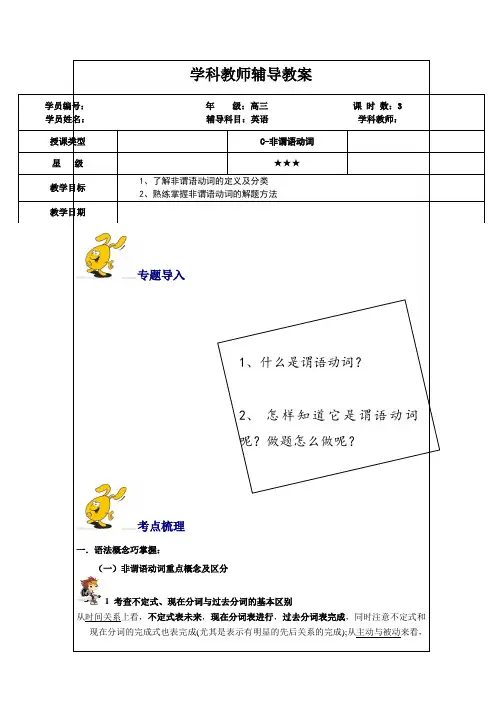
学科教师辅导教案专题导入考点梳理一.语法概念巧掌握:(一)非谓语动词重点概念及区分1 考查不定式、现在分词与过去分词的基本区别从时间关系上看,不定式表未来,现在分词表进行,过去分词表完成,同时注意不定式和现在分词的完成式也表完成(尤其是表示有明显的先后关系的完成);从主动与被动来看,学员编号: 年 级:高三 课 时 数:3 学员姓名: 辅导科目:英语 学科教师: 授课类型C-非谓语动词 星 级★★★ 教学目标1、了解非谓语动词的定义及分类2、熟练掌握非谓语动词的解题方法 教学日期1、什么是谓语动词?2、 怎样知道它是谓语动词呢?做题怎么做呢?不定式和现在分词表主动,过去分词表被动,同时注意不定式和现在分词的被动式也表被动(不定式的被动式在表被动的同时还兼表未来,现在分词的被动式表被动的同时还兼表进行)。
如: 1. I send you 100 dollars today, the rest _____ in a year.A. followsB. followedC. to followD. being followed分析:答案选C。
动词不定式表示未来的动作。
2. _____from other continents for millions of years, Australia has many plants and animalsnot found in any other country in the world.A. Being separatedB. Having separatedC. Having been separatedD. To be separated分析:答案选C。
因为Australia与separate是被动关系,且separate发生在谓语动词has之前,所以用现在分词的完成被动式作原因状语。
2 考查非谓语动词的主动式与被动式结合句子意思,考察非谓语动词与相应逻辑主语的关系,若为主动关系,用主动式;若为被动关系,用被动式。
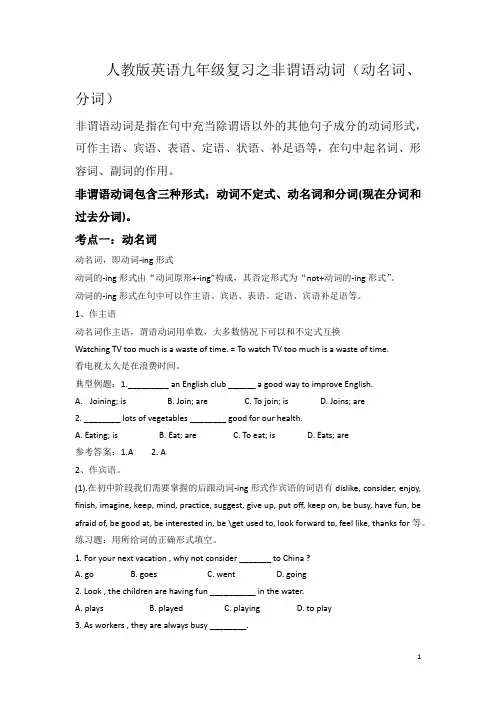
人教版英语九年级复习之非谓语动词(动名词、分词)非谓语动词是指在句中充当除谓语以外的其他句子成分的动词形式,可作主语、宾语、表语、定语、状语、补足语等,在句中起名词、形容词、副词的作用。
非谓语动词包含三种形式:动词不定式、动名词和分词(现在分词和过去分词)。
考点一:动名词动名词,即动词-ing形式动词的-ing形式由“动词原形+-ing”构成,其否定形式为“not+动词的-ing形式”。
动词的-ing形式在句中可以作主语、宾语、表语、定语、宾语补足语等。
1、作主语动名词作主语,谓语动词用单数,大多数情况下可以和不定式互换Watching TV too much is a waste of time. = To watch TV too much is a waste of time.看电视太久是在浪费时间。
典型例题:1._________ an English club ______ a good way to improve English.A.Joining; isB. Join; areC. To join; isD. Joins; are2. ________ lots of vegetables ________ good for our health.A. Eating; isB. Eat; areC. To eat; isD. Eats; are参考答案:1.A 2. A2、作宾语。
(1).在初中阶段我们需要掌握的后跟动词-ing形式作宾语的词语有dislike, consider, enjoy, finish, imagine, keep, mind, practice, suggest, give up, put off, keep on, be busy, have fun, be afraid of, be good at, be interested in, be \get used to, look forward to, feel like, thanks for等。
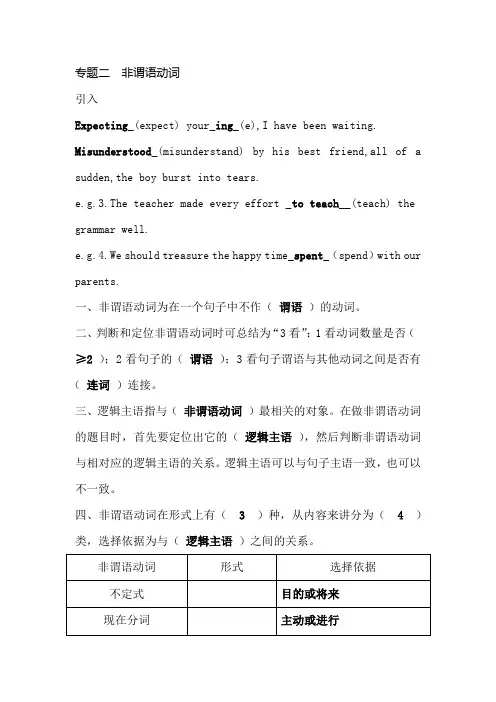
专题二 非谓语动词 引入 Expecting_(expect) your_ing_(e),I have been waiting. Misunderstood_(misunderstand) by his best friend,all of a sudden,the boy burst into tears. e.g.3.The teacher made every effort _to teach__(teach) the grammar well. e.g.4.We should treasure the happy time_spent_(spend)with our parents. 一、非谓语动词为在一个句子中不作( 谓语 )的动词。 二、判断和定位非谓语动词时可总结为“3看”:1看动词数量是否( ≥2 );2看句子的( 谓语 );3看句子谓语与其他动词之间是否有( 连词 )连接。 三、逻辑主语指与( 非谓语动词 )最相关的对象。在做非谓语动词的题目时,首先要定位出它的( 逻辑主语 ),然后判断非谓语动词与相对应的逻辑主语的关系。逻辑主语可以与句子主语一致,也可以不一致。 四、非谓语动词在形式上有( 3 )种,从内容来讲分为( 4 )类,选择依据为与( 逻辑主语 )之间的关系。 非谓语动词 形式 选择依据 不定式 目的或将来 现在分词 主动或进行 动名词 名词 过去分词 被动或完成 注意 1. 非谓语动词可以有主被动形式的变化。常考的如:不定式的主动形式为( to do ),被动形式为( to be done );现在分词和动名词的主动形式为( doing ),被动形式为( being done )。 2. 非谓语动词的否定形式为:直接在非谓语动词前加( not )。 e.g.1.The passage is shown here_to be corrected_(correct). Being used_(use)fully is the meaning of time. e.g.3.I got up early today_not to miss_(miss)the bus to school. 五、当非谓语动词在一个句子中作( 状语 )时,逻辑主语与句子主语一致;当非谓语动词在一个句子中作( 定语 )时,逻辑主语与句子主语不一致,被修饰的对象就是它的( 逻辑主语 )。 六、非谓语动词句子成分问题 非谓语动词在一个句子中不能作( 谓语 ),但是可以作句子的其他成分。即主语、( 宾语 )、表语、( 定语 )、宾语补足语和( 状语 )。 e.g.1 Learning English makes me more confident. e.g.2 She enjoys listening to English music. e.g.3 My aim this year is to go overseas. e.g.4 I don’t know the language spoken in the conference. e.g.5 The lesson got us to realize the meaning of a team. e.g.6 The people stayed up to see the shooting star. e.g.7.I am standing here,teaching you English. e.g.8.They won the petition,getting the prize. 七、非谓语动词在独立主格结构中的运用 结构:with/without + n./pron.+ 非谓语动词 特征如下:1.( 不是 )一个句子;2.作为( 状语 )出现在一个句子中,表示条件、( 原因 )、( 目的 )、( 结果 )、状态和( 伴随 )等;3.非谓语动词的逻辑主语为中间的( n./pron. );4.with( 可以 )省去;5.独立主格结构中的非谓语动词可替换为名词、( 形容词 )或介词短语等。6.位置不固定,可位于句首、( 句中 )或句末。 e.g.1.With the weather_permitting_(permit),we are about to go camping tomorrow. e.g.2.This letter is being written by me,with my advice_to be given_(give). e.g.3.They,with their goal_achieved_(achieve),are having tears in their eyes. e.g.4.There are 45 students in our class,with none of us foreigners. e.g.5.He finally came to my birthday party,with a bunch of flowers in his hand. 八、V.+ doing(单词) advise, allow, avoid, admit, appreciate, ban, consider, deny, delay, escape, enjoy, forbid, finish, imagine, keep, mind, permit, practice, quit, resist, risk, remend, suggest, succeed(in),spend…(in) 补充: 1. admit v. →admission n. permit v. →permission n. 2. consider v. →consideration n. considerate adj.体贴的,考虑周到的 considerable adj.相当大的,相当多的 3. succeed v. →success n.→successful adj. 4. practice n.练习,实践 practical adj.实际的 九、V.+ doing(短语) adjust to, adapt to, abandon… to, be busy, be/get used to, be/get accustomed to, be addicted to, be opposed to, can’t help, can’t stand, contribute to, devote to, feel like, give up, look forward to, have fun/trouble/difficulty, have a good/hard/wonderful time, get down to, lead to, object to, put off, pay attention to, set off, stick to, due to, thanks to, owing to, when it es to 十、V.+ to do agree, afford, arrange, attempt, be able, be about, be used, be eager, be ready, be (un)likely, be (un)willing, be supposed, be qualified, choose, dare,deserve, decide, determine, expect, fail, help(to), hope, happen, hesitate, intend, learn, long, manage, need, offer, prepare, pretend, promise, plan, refuse, seek, seem, struggle, set out, tend, used, volunteer, want, wish, would like 补充: 1.choose v. →choice n. choosechosechosenchoosing 2.deserve v. reserve v.预定,储备,保护区(n.) preserve v.保护,保存,蜜饯,果酱,保护区(n.) observe v.观察,看到,评论,遵守,庆祝 3.decide v. →decision n. determine v. →determination n. determined adj. expect v. →expectation n. fail v. →failure n. 4.offer sb.sth. offer sth. to sb. provide sb. with sth. provide sth. for sb. 十一、V.+sb.to do advise, allow, ask, appoint, beg, cause, mand, call on, drive, depend on, encourage, expect, enable, forbid, force, get, help…(to), invite, inspire, leave, need, order, permit, prefer, persuade, promise, remind, require, request, remend, rely on, tell, teach, urge, want, wish, warn, wait for, would like 补充: 1.encourage v. →encouragement n. 2.invite v. →invitation n. invent v. →invention n. invest v. →investment n. investigate v. →investigation n. 3.inspire v. →inspiration n.激励,灵感 4.remind sb. of sth. remind sb. to do sth. 十二、V.+ to do/doing 1.try doing/to do 2.stop doing/to do ’t help doing/to do 6.used to do/be used to do/be used to doing 十三、非谓语动词的其他常考点 (一)非谓语动词作为句子主语时视作( 单 )数。 e.g.Being confident is a kind of power. (二)常考的几个使役动词的用法 1.make 宾语 ( do ) 使宾语…… make 宾语 ( done ) 使宾语被…… 2.have 宾语 ( do ) 使宾语……
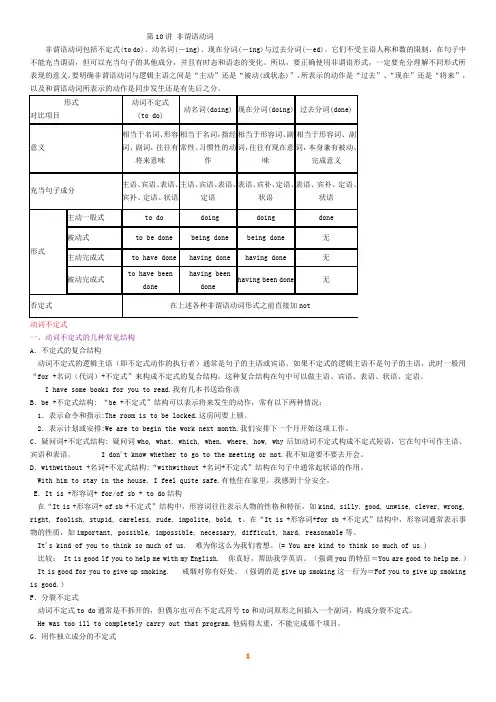
1 第10讲 非谓语动词 非谓语动词包括不定式(to do)、动名词(-ing)、现在分词(-ing)与过去分词(-ed)。它们不受主语人称和数的限制,在句子中不能充当谓语,但可以充当句子的其他成分,并且有时态和语态的变化。所以,要正确使用非谓语形式,一定要充分理解不同形式所表现的意义,要明确非谓语动词与逻辑主语之间是“主动”还是“被动(或状态)”,所表示的动作是“过去”、“现在”还是“将来”,以及和谓语动词所表示的动作是同步发生还是有先后之分。 形式 对比项目 动词不定式 (to do) 动名词(doing) 现在分词(doing) 过去分词(done)
意义 相当于名词、形容词、副词,往往有将来意味 相当于名词,指经常性、习惯性的动作 相当于形容词、副词,往往有现在意味 相当于形容词、副词,本身兼有被动、完成意义
充当句子成分 主语、宾语、表语、宾补、定语、状语 主语、宾语、表语、定语 表语、宾补、定语、状语 表语、宾补、定语、状语
形式 主动一般式 to do doing doing done 被动式 to be done being done being done 无 主动完成式 to have done having done having done 无 被动完成式 to have been done having been done having been done 无 否定式 在上述各种非谓语动词形式之前直接加not 动词不定式 一、动词不定式的几种常见结构 A.不定式的复合结构 动词不定式的逻辑主语(即不定式动作的执行者)通常是句子的主语或宾语。如果不定式的逻辑主语不是句子的主语,此时一般用“for +名词(代词)+不定式”来构成不定式的复合结构,这种复合结构在句中可以做主语、宾语、表语、状语、定语。 I have some books for you to read.我有几本书送给你读 B.be +不定式结构: “be +不定式”结构可以表示将来发生的动作,常有以下两种情况: 1.表示命令和指示:The room is to be locked.这房间要上锁。 2.表示计划或安排:We are to begin the work next month.我们安排下一个月开始这项工作。 C.疑问词+不定式结构: 疑问词who, what, which, when, where, how, why后加动词不定式构成不定式短语,它在句中可作主语、宾语和表语。 I don't know whether to go to the meeting or not.我不知道要不要去开会。 D.withwithout +名词+不定式结构:“withwithout +名词+不定式”结构在句子中通常起状语的作用。 With him to stay in the house, I feel quite safe.有他住在家里,我感到十分安全。 E.It is +形容词+ for/of sb + to do结构 在“It is +形容词+ of sb +不定式”结构中,形容词往往表示人物的性格和特征,如kind, silly, good, unwise, clever, wrong, right, foolish, stupid, careless, rude, impolite, bold, t。在“It is +形容词+for sb +不定式”结构中,形容词通常表示事物的性质,如important, possible, impossible, necessary, difficult, hard, reasonable等。 It's kind of you to think so much of us. 难为你这么为我们着想。(= You are kind to think so much of us.) 比较: It is good lf you to help me with my English. 你真好,帮助我学英语。(强调you的特征=You are good to help me.) It is good for you to give up smoking. 戒烟对你有好处。(强调的是give up smoking这一行为=Fof you to give up smoking is good.) F.分裂不定式 动词不定式to do通常是不拆开的,但偶尔也可在不定式符号to和动词原形之间插入一个副词,构成分裂不定式。 He was too ill to completely carry out that program.他病得太重,不能完成那个项目。 G.用作独立成分的不定式 2
非谓语动词云南省富源县第二中学唐老五动词除了在句子中充当谓语外,还具有名词、形容词及副词的性质动词的非谓语形式,可在句中作主语、表语、宾语、定语、补语和状语等,称作非谓语动词,包括动词不定式、分词和动名词。
一、动词不定式动词不定式的基本形式是“to+动词原形”,有时可以不带to。
动词不定式没有人称和数的变化,在句子中不能作谓语,但可以担任主语、表语、宾语、状语和宾语补足语。
动词不定式仍保留动词的一些特点。
(一)动词不定式的特征及用法1.动词不定式的构成及特征“to +动词原形”构成动词不定式,是一种非谓语形式,在句子中不能作谓语,没有人称和数的变化,它具有名词、形容词和副词的特征。
2.动词不定式的用法动词不定式具有名词、形容词和副词的特征,在句子中可以作主语、表语、宾语、定语和状语。
1.作主语例如:To learn English well is not easy. 或It is not easy to learn English well.动词不定式作主语时,往往用it作形式主语,这种句型可归纳为下面的句型:It is + adj.+ 动词不定式如果要说明不定式的动作执行者,可以用forIt is + adj.+ for sb. to do sth.:It is very important for you to learn English well.2.作表语:My wish is to become a teacher.3.作宾语:Most of us like to watch football matches.4.作宾语补足语:He told me to be here on time.5.作定语:I have nothing to say about that thing. This afternoon I have a lot of homework to do.6.作状语:He stopped to have a look.3.动词不定式的否定形式动词不定式的否定形式not + to + 动词原形例如:He asked me not to make such a mistake.4.动词不定式与疑问词连用疑问代词who, what, which和疑问副词when, where, how, why等后面可以接动词不定式,构成动词不定式短语,可以在句子中作主语、宾语、表语等成分。
例如:(1) He doesn’t know how to use the machine.(不定式作宾语)(2) How to use the machine is a question.(不定式作主语)(3) The question is when to go there.(不定式作表语)(二)动词不定式的时态和被动形式动词不定式是非谓语动词的一种,由不定式符号(to)加动词原形构成。
不定式的形式有五种:1.一般式to do 例如:I like to read English.2.进行式to be doing 例如:He seemed to be reading something at that time.3.完成式to have done 例如:He seemed to have cleaned the room.4.被动式to be done 例如:The work is to be done soon.5.完成被动式to have been done 例如:The boy is said to have been sent to hospital yesterday.二、分词分词是动词非谓语形式的一种,包括现在分词和过去分词。
现在分词表示:主动,动作正在进行。
过去分词表示:被动,动作已经完成。
(一)分词的作用分词在句中可以作定语、表语、状语和宾语补足语。
例如:1.作定语Do you know the boy standing at the gate?Have you read the book written by Lu Xun?2.作表语We are excited at the news.The news he told us is exciting.3.作宾语补足语I heard him singing a song in the classroom.We found the ground covered with snow.4.作状语While lying in bed, he listened to some music.Seen from the hill, the village looks move beautiful.分词作状语时,它的逻辑主语就是句子的主语,否则分词前面必须有自己的主语。
(二)分词的时态现在分词分一般式和完成式,而过去分词则没有时态形式的变化。
现在分词的一般式表示动作与谓语动词同时发生,或在谓语动词之前发生。
例如:Knowing his uncle would come, he began to make some preparations.现在分词的完成时,表示的动作发生在谓语动词表示的动作之前。
常用作状语。
例如:Having finished his homework, he went to bed.(三)现在分词的被动式被动一般式being done被动完成式having been doneThis is one of the new supermarkets being built in our city.Having been told many times, he was able to operate the machine.(四)分词的否定形式分词的否定式,由not+分词构成,例如:Not having heard the news. I wrote to him again.Not knowing how to work out the maths problem, I went to the teacher for help.(五)分词独立主格结构当分词的逻辑主语与主句的主语不同时,带逻辑主语的分词短语成为独立主格结构,在句法功能上起状语作用。
例如:Weather permitting, they will go and visit the science museum.The meeting being over, they all left the room.三、动名词动名词是动词非谓语形式的一种,由动词加ing构成。
动名词既有动词特征,也有名词特征。
动名词在句中可以作主语、表语、宾语和定语。
例如:⑴Smoking does great harm to people’s health.(作主语)⑵My job is looking after children.(作表语)⑶I have finished reading the novel.(作宾语)⑷We have got a swimming pool in our school.(做定语)动名词的否定形式由not +动名词构成。
例如:He made me angry by not taking the medicine.动名词的复合结构由名词所有格或物主代词加上动名词构成。
例如:Would you mind my opening the door?动名词的一般式,表示的动作可以与谓语动词同时发生或在前,或在后。
例如:We all enjoy listening to music.(同时发生)Do you remember meeting me there?(在谓语动词前发生)动名词的完成式表示在谓语动词之前完成的动作。
例如:I regret not having been taken to the Great Wall when I was a child.She attended the party without being invited.第二节实战演练一、复习时需注意的要点1.动词不定式一般式表示的动作可能与谓语动词的动作同时发生,也可能在其之后发生。
例如:I saw the young man enter the house.(同时发生)I hope to go there next time.(之后发生)2.不定式完成式表示不定式的动作在谓语动词之前发生。
例如:I’m sorry to have broken your glasses.3.不定式进行式表示不定式的动作,与谓语动词同时发生。
例如:When he came in, I happened to be reading at the table.4.不定式的被动式有两种形式:to be done表示将要被做,to have been done表示已被做。
例如:The new cinema to be put up next year will be very large.The cinema is said to have been built last year.5. 在表示情绪的动词,如like, love, hate, prefer等后,用动名词作宾语表示一般倾向,用不定式表示特定某事。
但在would/should like/love/prefer后要用不定式例如:I hate eating the same food every day.Would you like to watch TV in the evening?6. 在动词need, want, require后用动名词表示被动含义,相当于动词不定式的被动式;而用动词不定式的主动式表示主动含义。
例如:The house needs cleaning. = The house needs to be cleaned.He needs to clean the house first.7. 在介词后一般用动名词作宾语,但在少数介词,如but, except后用动词不定式作宾语,但要注意“to”的省略,如but前有“do”则省去“to”。
例如:I have done nothing but help him with his luggage.I have no choice but to wait for him at the bus stop.8. 分词的完成式一般不用来作定语,因此,要表示完成主动的意思常用定语从句。
例如:The accident which happened yesterday was very serious.9. 如果分词短语的逻辑主语与句子不是相同的,则要用从句或分词独立主格结构来表示。